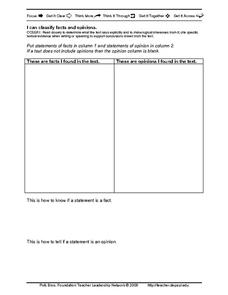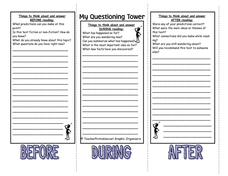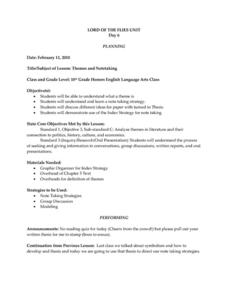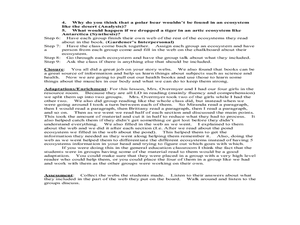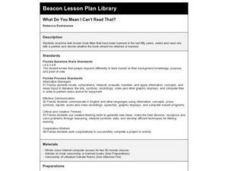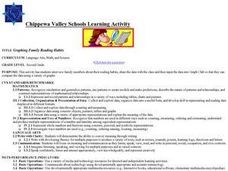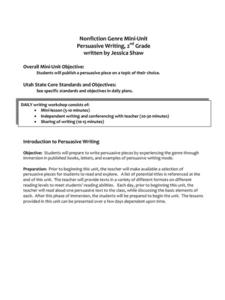Polk Bros Foundation
I Can Classify Facts and Opinions
Telling fact from opinion can be tricky. Direct your class to practice their reading and comprehension skills by taking notes on the facts and opinions in a text. Pupils fill out a two-column chart and write down how they know a...
Teacher Printables
My Questioning Tower
Good readers think about what they are reading. They ask questions and make predictions before beginning a text. While reading, they summarize what has happened and note what they have discovered. After finishing, they check to see if...
Polk Bros Foundation
I Can Sequence Important Events
After reading any short informational or fictional text, ask your class to analyze the important events. They note down three important events on a short timeline, describing the events with either words or drawings. After this, pupils...
Polk Bros Foundation
I Can Identify/Infer Motive
Why do people and characters act as they do? Require your class figure out the motivation of two people or characters they read about in a given text. In the short charts, pupils note down who, what they do, and why they do it. After...
Novelinks
Lord of the Flies: Themes and Notetaking
William Golding's Lord of the Flies is a treasure trove of symbolism and literary themes. Help your kids note the richest passages in the book with a instructional activity and graphic organizer. The instructional activity prepares...
Curated OER
The Heart of the Matter
Upper elementary pupils learn about the blood transportation system and anatomy of the human heart. They fill in an outline of the human heart (not included) focusing on the flow of blood to and from the heart. Using stethoscopes,...
Polk Bros Foundation
I Can Compare and Contrast
Work with your class to fill out this Venn diagram. Pupils can compare and contrast any two things and then write a short paragraph about the relationship demonstrated in their diagram.
Curated OER
Check My Writing
Use this resource as an evaluation tool, or have your class assess their own letter writing skills. They will use a checklist that they create during some interactive writing sessions as criteria for their self-evaluation. Teachers can...
Curated OER
Monster: Compare and Contrast
Helpful for a unit on Walter Dean Myers' Monster, or any novel that you are teaching, a graphic organizer prompts learners to compare and contrast different character traits. The first box has one set of lines to jot down what two...
Curated OER
Writer's Craft: Foreshadowing
Track instances of foreshadowing in any text with a straightforward graphic organizer. In one column, learners note down the events that happened, and in the other they list the clues that indicated that those events would happen. Some...
Novelinks
The Devil’s Arithmetic: Semantic Feature Analysis
Organize the characters in Jane Yolen's The Devil's Arithmetic according to their shared character traits. After listing character traits as a class, kids note which characters exhibit particular characteristics with a...
Curated OER
Graphic Organizers Aid Comprehension
Students create story webs to aid comprehension of ecosystems. In this reading strategies lesson plan, students discover the importance of organizing information while reading a nonfiction text. Students produce story webs to communicate...
Curated OER
Animals: Graphic Organizer
Second graders research information on the animal of their choice using the James E. Gerholt animal series books. They create a graphic organizer (concept web) using Kid Pix Deluxe 3 software, display information on screen, and create a...
Curated OER
Language Arts: Reading for Information
Sixth graders discover how to turn book titles into questions in order to locate the information during their reading. Using t-charts, they list titles and subtitles with the questions they suggest. Gradually, 6th graders progress from...
Curated OER
A Similar Look at Another Text
Second graders read stories about relationships and record their thoughts using a "Before" and "After" organizer.
Curated OER
During Reading Strategies
Students employ strategies to increase comprehension while they are reading. For this language arts lesson, students must infer, predict and visualize in order to improve comprehension.
Curated OER
Descriptive Persuasive Texts
In this Language Arts worksheet, students read about persuasive writing. Students read an example and complete a chart that organizes the information into facts and opinions.
Curated OER
What Do You Mean I Can't Read That?
Fourth graders discuss censorship/banned books. They select and read one banned book. They conduct research to find the pro and con positions on the book. They present the book to the class.
Curated OER
Lesson 3: Predicting Beyond the Text
Second graders make predictions beyond the text. In this prediction instructional activity, 2nd graders read a story and predict what happens to the characters after the story is over by using evidence from what they read. They read...
Curated OER
Graphing Family Reading Habits
Second graders collect data from their families about their reading habits and graph them. In this graphing family reading habits instructional activity, 2nd graders interview family members about their reading habits. They then use a...
Curated OER
Text Clues and Background Knowledge
Teach youngsters how to evaluate background knowledge, pictures, and context clues to draw a reasonable conclusion about a story. They practice using the discussed clues as they read the story, Alexander and the Terrible, Horrible,...
Curated OER
Problem-Solving Strategy: Make an Organized List
In this organized list worksheet, students review the problem solving strategy of reading for information and using a math model or organized list to solve the problem. Students then complete the two problems by using organized lists.
Curated OER
Nonfiction Genre Mini-Unit: Persuasive Writing
Should primary graders have their own computers? Should animals be kept in captivity? Young writers learn how to develop and support a claim in this short unit on persuasive writing.
Southern Nevada Regional Professional Development Program
Was Bias A Factor? Make an Argument
The ability to analyze an argument is a skill emphasized by the Common Core standards. Offer your class an opportunity to develop and hone their skills by providing them the testimonies in an Oregon court case. After reading the facts of...
